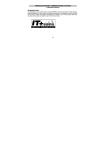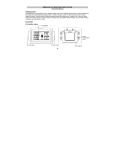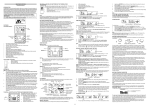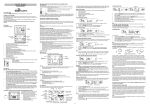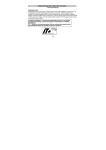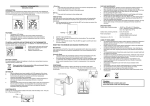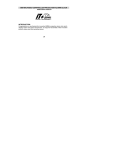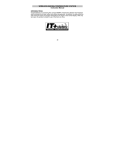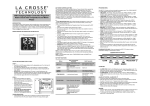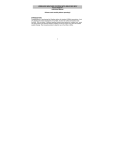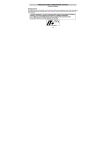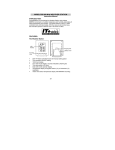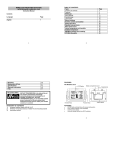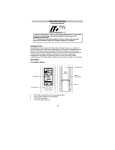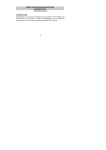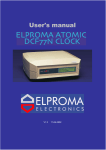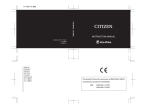Download WIRELESS 868 MHz WEATHER STATION
Transcript
WIRELESS 868 MHz WEATHER STATION Instruction Manual INTRODUCTION: Congratulations on purchasing this Weather station with wireless 868MHz transmission. It not only displays the indoor temperature and humidity but also receives the outdoor temperature. It is further acting as a DCF-77 radio controlled clock. With a total of 15 different weather forecast icons featured by "Weather man", users can easily observe the forecast weather condition and will no longer worry the sudden weather change. This innovative product is ideal for use in the home or office. 37 FEATURES: The Weather station Hanging hole Battery compartment cover LCD Display Foldout Stand Function Keys 38 • • • • • • • • • • • • • • • • • DCF Radio controlled time function or manual time setting options DCF time reception ON/OFF setting 12/24 hour display Hour and minute display Calendar display Time zone option ±12 hours Wireless transmission at 868 MHz Signal reception intervals at 4-second Display indoor and outdoor temperature Display indoor humidity (% RH) Temperature displayed in degrees Celsius (°C) or Fahrenheit (°F) selectable Weather forecasting with 15 easy-to-read weather forecast signs featured by Weather man Indoor comfort level indicator Indoor and Outdoor temperature display with MIN/MAX recording All MIN/MAX recordings can be reset Low battery indicator Table standing/ Wall mounting 39 The Outdoor Temperature Transmitter • • • Remote transmission of outdoor temperature to Weather Station by 868 MHz Shower proof casing Wall mounting case (Mounting at a sheltered place. Avoid direct rain and sunshine) SETTING UP: Note: This weather station receives only one outdoor transmitter. 1. 2. First, insert the batteries into the Temperature transmitter. (see “Install and replace batteries in the Temperature transmitter“). Immediately after and within 30 seconds, insert the batteries into Weather station (see “Install and replace batteries in the Weather station”). Once the batteries are in place, all segments of 40 3. 4. 5. the LCD will light up briefly. Following the time as 0:00 and the "Weather man" icon will be displayed. If these are not displayed after 60 seconds, remove the batteries and wait for at least 10 seconds before reinserting them. After inserting the batteries, the Weather station will start receiving data from the transmitter. The outdoor temperature and the signal reception icon should then be displayed on the Weather station. If this does not happen after 3 minutes, the batteries will need to be removed from both units and reset from step 1. In order to ensure sufficient 868 MHz transmission however, this should under good conditions be a distance no more than 100 meters between the final position of the Weather Station and the transmitter (see notes on “Mounting” and “868 MHz Reception”). Once the remote temperature has been received and displayed on the Weather station, the DCF time (radio controlled time) code reception is automatically started. This takes typically between 3-5 minutes in good conditions. Note: Daily DCF reception is done at 02:00 and 03:00 every day. If the reception at 03:00 is not successful, then at 04:00 and 05:00 and 06:00 there are other tries, until one is successful. If the reception at 06:00 is still not successful, then the next try takes place at 02:00 next day. 41 If reception is successful, the received time will override the manually set time. The date is also updated with the received time. (Please refer also to notes on “DCF-77 Radio Controlled Time” and “Manual Time Setting”) INSTALL AND REPLACE BATTERIES IN THE WEATHER STATION The Weather station uses 2 x AAA, IEC LR3, 1.5V batteries. To install and replace the batteries, please follow the steps below: 1. Remove the cover at the back of the Weather station. 2. Insert batteries observing the correct polarity (see marking). 3. Replace compartment cover. 42 INSTALL AND REPLACE BATTERIES IN THE TEMPERATURE TRANSMITTER The Temperature Transmitter uses 2 x AA, IEC LR6, 1.5V battery. To install and replace the batteries, please follow the steps below: 1. Remove the battery compartment cover at the back of the transmitter. 2. Insert the batteries, observing the correct polarity (see marking). 3. Replace the battery compartment cover on the unit. Note: In the event of changing batteries in any of the units, all units need to be reset by following the setting up procedures. This is because a random security code is assigned by the transmitter at start-up and this code must be received and stored by the Weather station in the first 3 minutes of power being supplied to it. BATTERY CHANGE: It is recommended to replace the batteries in all units regularly to ensure optimum accuracy of these units (Battery life See Specifications below). Please participate in the preservation of the environment. Return used batteries to an authorised depot. 43 FUNCTION KEYS: Weather station: The weather station has four easy to use function keys. OUT key SET key IN key + key SET key • Press and hold the key to enter manual setting modes: Time zone, Manual time, Calendar, Time reception ON/OFF, 12/24 hour display and Temperature unit °C/°F setting + key • To make adjustment for various settings IN key • Press to display the MIN and MAX indoor temperature records 44 • Press and hold to reset the indoor MIN/MAX temperature records OUT key • Press to display the MIN and MAX outdoor temperature records • Press and hold to reset the outdoor MIN/MAX temperature records 45 LCD SCREEN AND SETTINGS: Outdoor temperature Transmitter low battery indicator Outdoor reception signal* Receiver low battery indicator Weather tendency icon Indoor Relative humidity % Indoor comfort indicator Weather forecast icon Weather forecast icon (Weather man) Indoor temperature Date Radio controlled time reception icon Time 46 * When the outdoor signal is successfully received by the Weather Station, this icon will be switched on. (If not successful, the icon will not be shown in LCD) So user can easily see whether the last reception was successful (icon on) or not (icon off). For better distinctness the LCD screen is split into 3 sections: Section 1 - OUTDOOR TEMPERATURE • Display the outdoor temperature. • Display the signal reception symbol indicating that receiver is receiving outdoor data Section 2 - INDOOR TEMPERATURE, INDOOR HUMIDITY, DATE AND WEATHER MAN ICON • Display the current indoor temperature and humidity in normal display. • Display the weather condition to be expected in form of 15 weather symbols (featured by Weather man) which change their appearance depending on the air pressure development and the current outdoor temperature. • Display the weather tendency indicator and indoor comfort level indicator • Display the date Section 3 - TIME • Display the current time. 47 • A signal reception symbol is shown indicating that Atomic time (DCF time) signal is received. DCF-77 RADIO CONTROLLED TIME: The time base for the radio controlled time is a Cesium Atomic Clock operated by the Physikalisch Technische Bundesanstalt Braunschweig which has a time deviation of less than one second in one million years. The time is coded and transmitted from Mainflingen near Frankfurt via frequency signal DCF-77 (77.5 kHz) and has a transmitting range of approximately 1,500 km. Your radio-controlled Weather station receives this signal and converts it to show the precise time in summer or wintertime. The quality of the reception depends greatly on the geographic location. In normal cases, there should be no reception problems within a 1,500 km radius around Frankfurt. Once the outdoor temperature is displayed on the Weather station after initial set-up, the DCF tower icon in the clock display will start flashing in the upper left corner. This indicates that the clock has detected that there is a radio signal present and is trying to receive it. When the time code is received, the DCF tower becomes permanently lit and the time will be displayed. If the tower icon flashes, but does not set the time or the DCF tower does not appear at all, then please take note of the following: • Recommended distance to any interfering sources like computer monitors or TV sets is a minimum of 1.5 - 2 metres. 48 • Within ferro-concrete rooms (basements, superstructures), the received signal is naturally weakened. In extreme cases, please place the unit close to a window and/or point its front or back towards the Frankfurt transmitter. MANUAL SETTINGS: The following manual settings can be done in the setting mode: • Time zone • Manual time • Calendar • Time reception ON/OFF (DCF) • 12/24 hour display • Temperature unit °C/°F setting Press and hold the SET key for about 3 seconds to advance to the setting mode: TIME ZONE SETTING: Time zone (flashing) 49 The time zone default is "0 hour". To set a different time zone: 1. The current time zone value starts flashing. 2. Use the + key to set the time zone. The range runs from 0, -1, -2…-12, 12, 11, 10… 2, 1, 0, in consecutive 1-hour intervals. 3. Confirm with the SET key and enter the Manual Time setting. MANUAL TIME SETTING In case the Weather station is not able to detect the radio-controlled time (DCF time) signal (disturbances, transmitting distance, etc.), the time can be manually set. The clock will then work as a normal Quartz clock. Hours (flashing) Minutes (flashing) To set the clock: 1. The hour digits start flashing in the time display section. 2. Use the + key to adjust the hours and then press SET key to go to the minute setting. 3. The minute will be flashing. Press the + key to just the minutes. 4. Confirm with the SET key and enter the “Calendar Setting”. 50 CALENDAR SETTING Year "Day. Month." (for 24h time display) "Month. Day." (for 12h time display) The date default of the Weather station is 1. 1. of the year 2006 after initial set-up. Once the radiocontrolled time signals are received, the date is automatically updated. However, if the signals are not received, the date can also be set manually. To do this: 1. Using the + key, set the year required. The range runs from 2000 to 2029 (default is 2006). 2. Press the SET key to enter the month setting mode. 3. The month digit will be flashing. Press the + key to set the month and then press the SET key to go to the date setting. 4. The date digit will be flashing. Press the + key to set the date. 5. Confirm with the SET key and enter the “Time reception On/Off setting". 51 TIME RECEPTION ON/OFF SETTING flashing In area where reception of the radio-controlled time (DCF time) is not possible, the time reception function can be turned OFF. The clock will then work as a normal Quartz clock. (Default setting is ON). 1. The digit “ON” and the "dCF" digits will start flashing on the LCD. 2. Use the + key to turn OFF the time reception function if necessary. 3. Confirm with the SET key and enter the “12/24-Hour Display setting”. Note: If the Time Reception function is turned OFF manually, the clock will not attempt any reception of the radio-controlled time (DCF time) as long as the Time Reception OFF function is activated. The Time Reception icon will not be displayed on the LCD. 52 12/24 HOUR TIME DISPLAY SETTING flashing 1. 2. 3. After setting time reception ON/OFF, press the SET key, “12h” or “24h” flashes in the LCD. (default 24 h) Press the + key to select the “12h” or “24h” display mode. Press the SET again to confirm and to enter the “°C/°F Temperature unit setting”. Note: When 24h mode display is selected, the calendar format will be "Day. Month." display. When 12h mode display is selected, the calendar format will be "Month. Day." display. °C/°F TEMPERATURE UNIT SETTING flashing 53 The default temperature reading is set to °C (degree Celsius). To select °F (degree Fahrenheit): 1. The “°C or °F” will be flashing, use the + key to toggle between “°C” and “°F”. 2. Once the desired temperature unit has been chosen, confirm with the SET key and exit the setting mode. WEATHER FORECAST AND TENDENCY: The weather forecast icons (Weather man): One of the 15 different weather icons (featured by Weather man with different clothing) is displayed in the centre of LCD, which indicates the different forecast weather conditions (Sunny, Sunny + Cloudy or Cloudy + Rainy) due to change in air pressure level and the current outdoor temperature: 54 ≥ 26°°C (78.8°°F) 19 to 25.9°°C (66.2 to 78.6°°F) Sunny 55 10 to 18.9°°C (50 to 66°°F) 0 to 9.9°°C (32 to 49.8°°F) < 0°°C (32°°F) ≥ 26°°C (78.8°°F) 19 to 25.9°°C (66.2 to 78.6°°F) Sunny + Cloudy 56 10 to 18.9°°C (50 to 66°°F) 0 to 9.9°°C (32 to 49.8°°F) < 0°°C (32°°F) ≥ 26°°C (78.8°°F) 19 to 25.9°°C (66.2 to 78.6°°F) Cloudy + Rainy 57 10 to 18.9°°C (50 to 66°°F) 0 to 9.9°°C (32 to 49.8°°F) < 0°°C (32°°F) For every sudden or significant change in the air pressure, the weather icons will update accordingly to represent the change in weather. If the icons do not change, then it means either the air pressure has not changed or the change has been too slow for the Weather Projection Station to register. However, if the icon displayed is a sun or raining cloud, there will be no change of icon if the weather gets any better (with sunny icon) or worse (with rainy icon) since the icons are already at their extremes. The icons displayed forecasts the weather in terms of getting better or worse and not necessarily sunny or rainy as each icon indicates. For example, if the current weather is cloudy and the rainy icon is displayed, it does not mean that the product is faulty because it is not raining. It simply means that the air pressure has dropped and the weather is expected to get worse but not necessarily rainy. Note: After setting up, readings for weather forecasts should be disregarded for the next 12-24 hours. This will allow sufficient time for the Weather station to collect air pressure data at a constant altitude and therefore result in a more accurate forecast. Common to weather forecasting, absolute accuracy cannot be guaranteed. The weather forecasting feature is estimated to have an accuracy level of about 75% due to the varying areas the Weather station has been designed for use in. In areas that experience sudden changes in weather (for example from sunny to rain), the Weather station will be more accurate compared to use in areas where the weather is stagnant most of the time (for example mostly sunny). 58 If the Weather station is moved to another location significantly higher or lower than its initial standing point (for example from the ground floor to the upper floors of a house), remove the batteries and re-insert them after about 30 seconds. By doing this, the Weather station will not mistake the new location as being a possible change in air-pressure when really it is due to the slight change of altitude. Again, disregard weather forecasts for the next 12 to 24 hours as this will allow time for operation at a constant altitude. THE WEATHER TENDENCY INDICATOR Working together with the weather icons are the weather tendency indicators (the upward and downward arrow located near the Weather man). When the indicator points upwards, it means that the air-pressure is increasing and the weather is expected to improve, but when indicator points downwards, the air-pressure is dropping and the weather is expected to become worse. Therefore, user may see how the weather has changed and is expected to change. For example, if the indicator is pointing downwards together with cloudy icons, it means that the last noticeable change in the 59 weather was when it was sunny (the sunny icon only). Therefore, the next change in the weather will be the cloudy icons since the indicator is pointing downwards. Note: • Once the weather tendency indicator has registered a change in air pressure, it will remain permanently visualized on the LCD. • When the tendency indicator is pointing to the right, it means that no pressure change has been detected by the weather station from the beginning. Therefore, the coming weather condition is expected to be more or less the same as the current condition. TREND The coming weather condition is expected to be more or less the same as the current condition THE COMFORT LEVEL INDICATOR: The comfort level indicator is located at the right of the weather man icon: Comfortable : A happy face icon “☺” indicating a temperature level between 20°C and 25.9°C and relative humidity reading between 45% and 65%. Uncomfortable : A sad face icon “” indicating any value outside the comfortable range. 60 DISPLAY OF INDOOR TEMPERATURE AND HUMIDITY READING: The indoor temperature and humidity are measured and displayed on the second section of the LCD. Indoor Relative Humidity % Indoor icon Indoor Temperature DISPLAY OF OUTDOOR TEMPERATURE READING: The outdoor temperature is measured and displayed on the first section of the LCD. Outdoor icon Outdoor Temperature 61 DISPLAY OF INDOOR MAXIMUM AND MINIMUM TEMPERATURE RECORDS: 1. 2. In normal display mode, press the IN button once. The min indoor temperature will be shown in the LCD. Then press the IN button one more time, the max indoor temperature will be shown: Max icon Indoor icon Max indoor temperature 3. Press one more time the IN button to go back to the normal display. 62 RESETTING THE INDOOR MAXIMUM/ MINIMUM RECORDS Note: The indoor minimum and maximum records will be reset at the same time 1. 2. In normal display mode, press the IN key once. The min indoor temperature will be displayed. Then press and hold the IN key for about 3 seconds, this will reset the indoor minimum and maximum temperatures to the current value. DISPLAY OF OUTDOOR MAXIMUM AND MINIMUM TEMPERATURE RECORDS: Outdoor icon Min outdoor temperature Min icon 1. 2. 3. Press the OUT button once, the min outdoor temperature will be displayed. By pressing OUT button once more, the max outdoor temperature will be shown. Press one more OUT button to advance to normal display. 63 RESETTING THE OUTDOOR MAXIMUM/ MINIMUM TEMPERATURE RECORDS Note: The outdoor minimum and maximum records will be reset at the same time. 1. 2. In normal display mode, press the OUT key once. The min outdoor temperature will be displayed. Then press and hold the OUT key for about 3 seconds, this will reset the outdoor minimum and maximum temperatures to the current value. LOW BATTERY INDICATOR Low battery indicator is displayed on the LCD when the batteries require changing. 868 MHz RECEPTION The Weather station should receive the temperature data within 5 minutes after set-up. If the temperature data is not received 5 minutes after setting up (not successfully continuously, the outdoor display shows “- -” ), please check the following points: 1. The distance of the Weather station or transmitter should be at least 1.5 to 2 meters away from any interfering sources such as computer monitors or TV sets. 2. Avoid positioning the Weather station onto or in the immediate proximity of metal window frames. 3. Using other electrical products such as headphones or speakers operating on the same signal frequency (868MHz) may prevent correct signal transmission and reception. 64 4. Neighbours using electrical devices operating on the 868MHz signal frequency can also cause interference. Note: When the 868MHz signal is received correctly, do not re-open the battery cover of either the transmitter or Weather station, as the batteries may spring free from the contacts and force a false reset. Should this happen accidentally then reset all units (see Setting up above) otherwise transmission problems may occur. The transmission range is about 100 m from the transmitter to the Weather station (in open space). However, this depends on the surrounding environment and interference levels. If no reception is possible despite the observation of these factors, all system units have to be reset (see Setting up). 65 MOUNTING POSITIONING THE WEATHER STATION: The Weather Station may be hung onto wall easily or free standing. To wall mount Choose a sheltered place. Avoid direct rain and sunshine. Before wall mounting, please check that the outdoor temperature values can be received from the desired locations. 1. Fix a screw (not supplied) into the desired wall, leaving the head extended out the by about 5mm. 2. Remove the stand from the Weather Station by pulling it away from the base and hang the station onto the screw. Remember to ensure that it locks into place before releasing. Free standing With the foldout stand, the weather station can be placed onto any flat surface. 66 POSITIONING THE TEMPERATURE TRANSMITTER: The Transmitter is supplied with a holder that may be attached to a wall with the two screws supplied. The Transmitter can also be position on a flat surface by securing the stand to the bottom to the Transmitter. To wall mount: 1. Secure the bracket onto a desired wall using the screws and plastic anchors. 2. Clip the remote temperature sensor onto the bracket. Note: Before permanently fixing the transmitter wall base, place all units in the desired locations to check that the outdoor temperature reading is receivable. In event that 67 the signal is not received, relocate the transmitters or move them slightly as this may help the signal reception. CARE AND MAINTENANCE: • • • • • • • Extreme temperatures, vibration and shock should be avoided as these may cause damage to the unit and give inaccurate forecasts and readings. Precautions shall be taken when handling the batteries. Injuries, burns, or property damage may be resulted if the batteries are in contact with conducting materials, heat, corrosive materials or explosives. The batteries shall be taken out from the unit before the product is to be stored for a long period of time. Immediately remove all low powered batteries to avoid leakage and damage. Replace only with new batteries of the recommended type. When cleaning the display and casings, use a soft damp cloth only. Do not use solvents or scouring agents as they may mark the LCD and casings. Do not submerge the unit in water. Special care shall be taken when handling a damaged LCD display. The liquid crystals can be harmful to user's health. Do not make any repair attempts to the unit. Return them to their original point of purchase for repair by a qualified engineer. Opening and tampering with the unit may invalidate their guarantee. 68 • • Never touch the exposed electronic circuit of the device as there is a danger of electric shock should it become exposed. Do not expose the units to extreme and sudden temperature changes, this may lead to rapid changes in forecasts and readings and thereby reduce their accuracy. SPECIFICATIONS: Recommended operating temperature range : 0ºC to 50ºC Temperature measuring range: Indoor : -9.9ºC to +59.9ºC with 0.1ºC resolution (14.1°F to +139.8°F with 0.2°F resolution) “OF.L” displayed if outside this range Outdoor : -39.9ºC to +59.9ºC with 0.1ºC resolution (-39.8°F to +139.8°F with 0.2°F resolution) “OF.L” displayed if outside this range Relative humidity measuring range: Indoor : 1% to 99% with 1% resolution (displays “- -” when lower than 1 %; displays "99" % if higher than 99 %) Indoor temperature checking interval : every 15 seconds Indoor humidity checking interval : every 20 seconds 69 Outdoor data reception Power consumption: Weather station Temperature transmitter Battery life cycle Dimensions (L x W x H) Weather station Temperature transmitter : every 4 seconds : : : 2 x AAA, IEC, LR3, 1.5V 2 x AA, IEC, LR6, 1.5V Approximately 24 months (Alkaline batteries recommended) : : 83 x 25 x 150 mm 38.2 x 21.2 x 128.3 mm LIABILITY DISCLAIMER: • • • • • The electrical and electronic wastes contain hazardous substances. Disposal of electronic waste in wild country and/or in unauthorized grounds strongly damages the environment. Please contact your local or/and regional authorities to retrieve the addresses of legal dumping grounds with selective collection. All electronic instruments must from now on be recycled. User shall take an active part in the reuse, recycling and recovery of the electrical and electronic waste. The unrestricted disposal of electronic waste may do harm on public health and the quality of environment. As stated on the gift box and labeled on the product, reading the “User manual” is highly recommended for the benefit of the user. This product must however not be thrown in general rubbish collection points. 70 • • • • The manufacturer and supplier cannot accept any responsibility for any incorrect readings and any consequences that occur should an inaccurate reading take place. This product is designed for use in the home only as indication of the temperature and other weather data. This product is not to be used for medical purposes or for public information. The specifications of this product may change without prior notice. This product is not a toy. Keep out of the reach of children. No part of this manual may be reproduced without written authorization of the manufacturer. R&TTE Directive 1999/5/EC Summary of the Declaration of Conformity : We hereby declare that this wireless transmission device does comply with the essential requirements of R&TTE Directive 1999/5/EC. 71



































